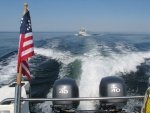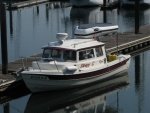colbysmith":3jaorn1k said:
The first time you use your radar to get back home when the fog rolls in on you, will more than pay for itself. Anyone that is going to do any serious boating in open or waters with other traffic, should prioritize it right up there with a chartplotter and depth sounder! And practice using it in good clear weather as well also, before needing it in the dark or fog! Colby
Agree, for sure. I live on the south shore of Juan de Fuca Strait and cross that piece of water several times a year. There, AIS is my most used safe navigation device, right next to radar even in clear weather. I spend most of my boating time in BC waters, and have been on the water at some time or another nearly year around. I have been a believer in radar since day one. Honestly, I probably would have balked at paying for that "extra accessory" IF I had been buying a new boat, thinking sure, I can just wait until the fog lifts. And I could. But there are times when I doesn't, or it drops onto you like wet blanket and stays, right out of a blue sky. Although I run my radar if the boat is running, I would say I seriously needed it about 25% of the time. (OK, lets do that math, 1400 hours on the engines, that comes to 350 hours of useful radar time.) NOAA defines fog as visibility of less than 1 mile. On our boats, at our speeds, that is a lot of visibility. For me, at 1/2 mile the fog horn comes on and my speeds slow, At 1/4 mile the side windows open and the speed goes down to 2-3 knots. At each step the radar is zoomed in from 6 - 3 - 1.5 miles. So serious, thick fog might be half of those 350 hours, so in the neighborhood of 100 - 200 hours.
Actually, I am surprised at 350 hours. I had no idea it was that much, but I know there are plenty of times.
As Colby said, "The first time you use your radar to get back home when the fog rolls in on you, will more than pay for itself." Or if it keeps you from getting splattered all over the front of some guys tin boat as he is running home in the fog, slowed down to 20 knots and sitting in his cockpit staring at his GPS track because that is the say he came out so it should be clear to go back in on.
Prioritize both the radar and the AIS, and in knowing how to use them reliably.
Cruising in the PNW watch the weather. Look for a good (stable) high pressure zone. That should give good (predictable) crossing conditions, and dry days.
Harvey
SleepyC :moon



